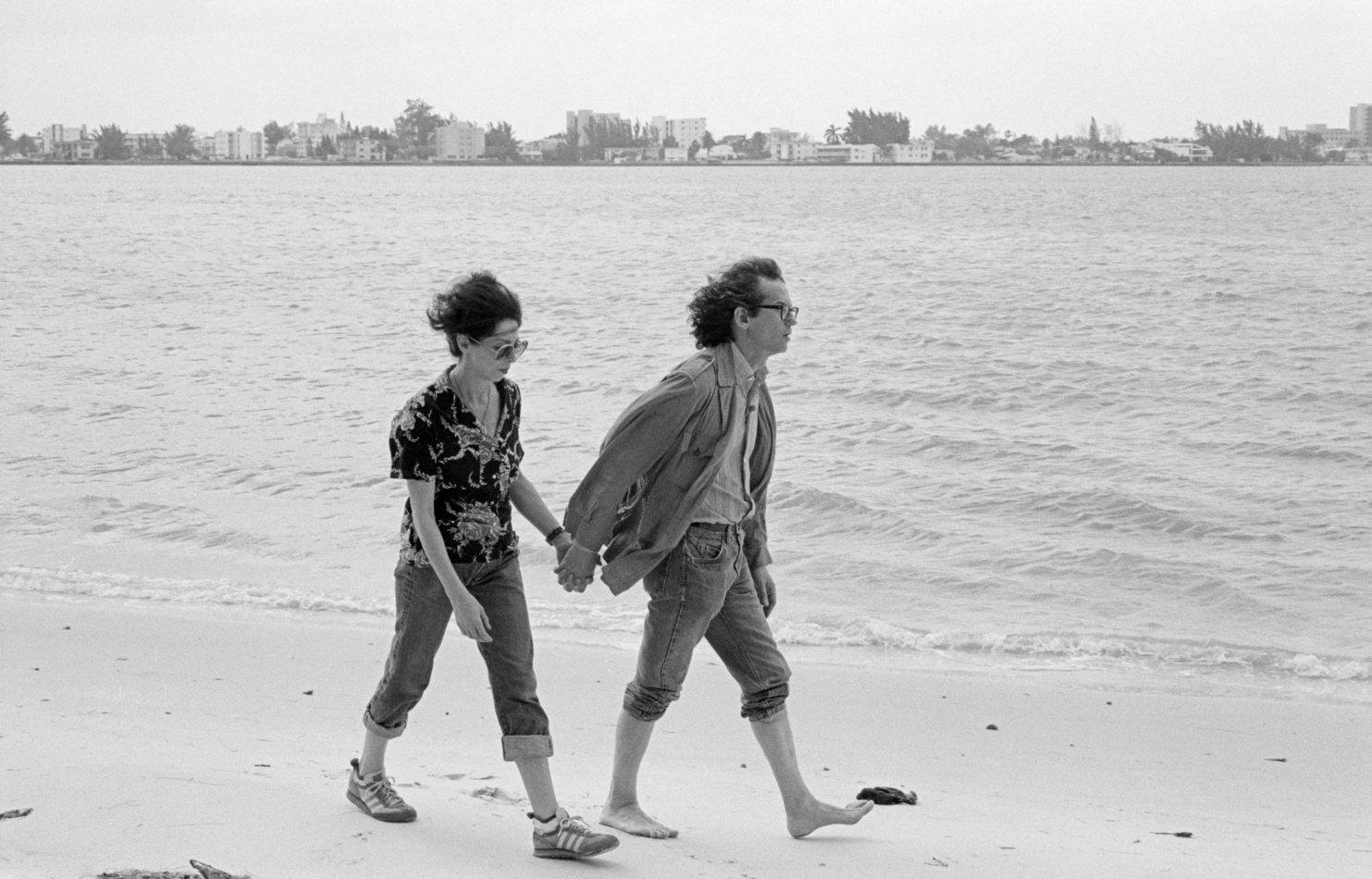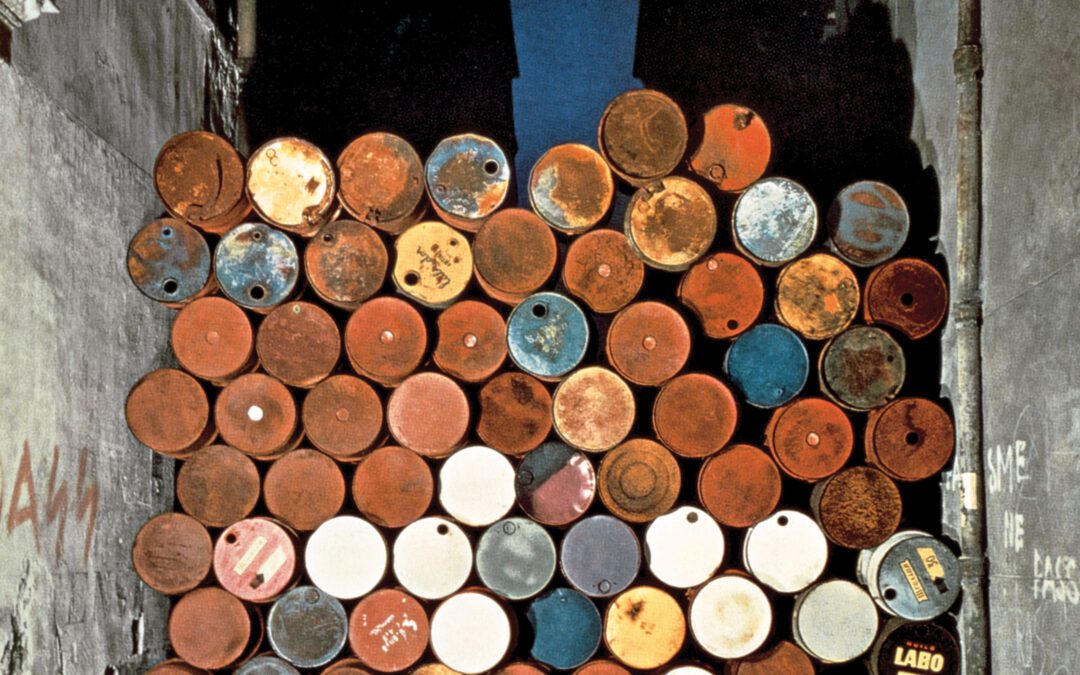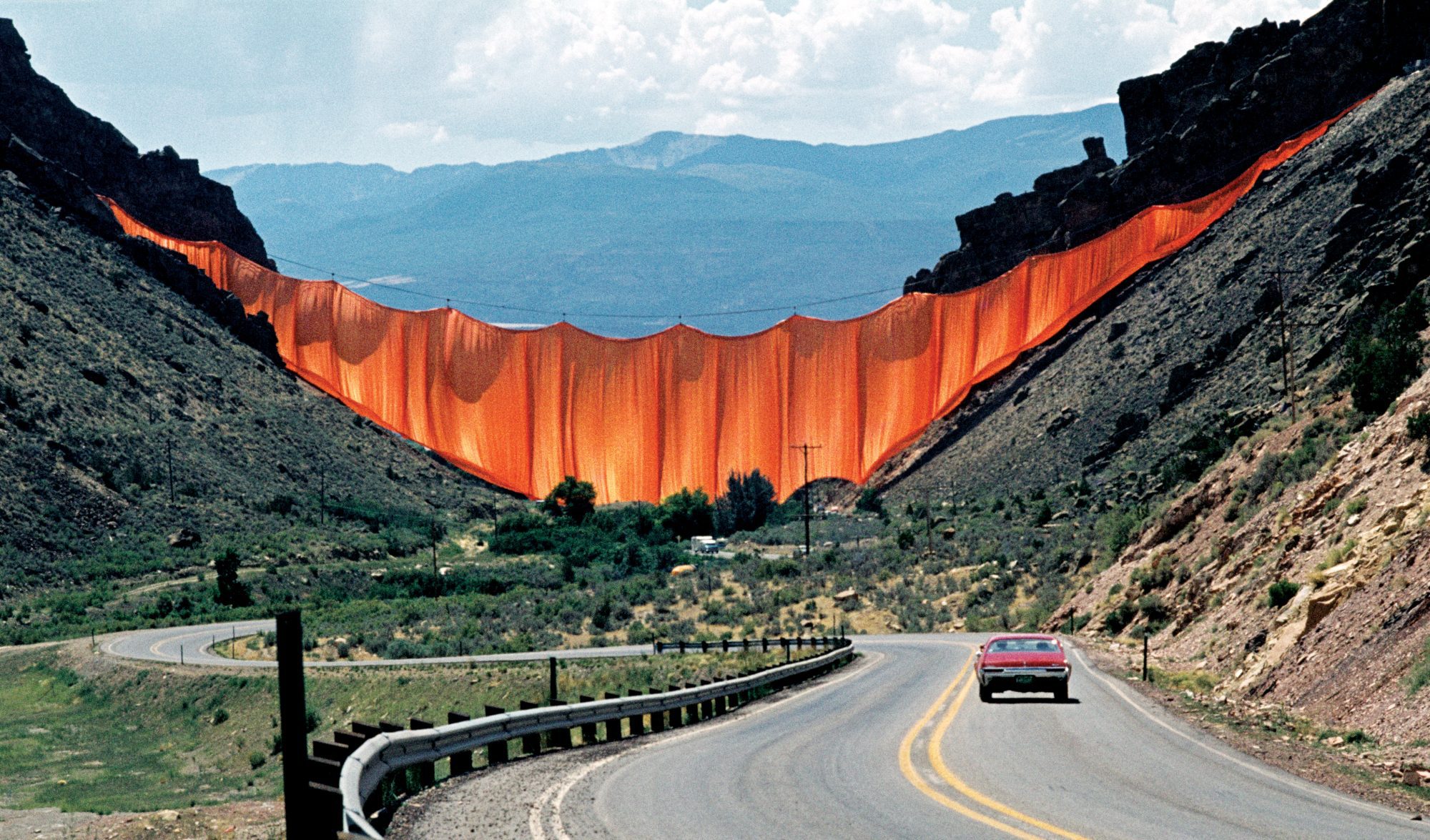
Christo’s early schooling in Soviet Socialist Realism and his experience leaving his home as a political refugee shaped his many career-long forays into real-life politics as a main source of inspiration for his art. Some of the biggest accomplishments in the early history of site-specific art are the large-scale installation pieces he co-authored with his wife, Jeanne-Claude, and their 35-year cooperation.
Together, the two created enormously sized sculptures and interventions which often made use of the method of covering or wrapping huge sections of existing buildings, industrial objects, and landscapes with specially designed fabric. Although they frequently maintained that the aesthetic qualities of their work were its main significance, responses from viewers and critics around the globe have long acknowledged a more comprehensive commentary at work. With themes ranging from the preservation of democratic and humanist ideals to the complex history of the 20th century and the Cold War, to environmental degradation.

The accomplishments of Christo and Jean Claude
- Through their interventions in both natural and built environments, Christo and Jeanne-Claude changed the physical form and the visual experience of the sites, giving viewers a fresh perspective on their formal, energetic, and volumetric qualities.
- Much of the artists’ work has an inherent element of protest and resistance because of their decision to alternate between staying inside and outside of legal systems. It also builds upon and strengthens a long-standing tradition of quasi-legality in the arts, according to which the “real” world and imagination are separated, as it grants the art world with special rights and limitations.
- Christo and Jeanne-Claude regularly operated outside of the gallery system, declining to deal with commissions and sales of drawings via an art dealer. By taking a firm stand against the political and economic framework of the international art market, they established a standard for artists who operate outside of established systems and yet achieve considerable success on a worldwide scale.
- Christo and Jeanne-Claude’s art focused on creating a strong contrast between the engineered, man-made elements and the site’s organic features, in contrast to Land Artists who typically made a point of erasing the lines of demarcation between the art work itself and its natural setting and/or materials. Thus, their work expands the genre discourse to include contentious issues of industrialization, bureaucratization, and late capitalism, and pushes the boundaries of what is considered site-specific, large-scale installation art.

“We borrow space and create gentle disturbance for a few days. We inherit everything that is inherent in the space to become part of the work of art. All our projects are like fabulous expeditions. The story of each project is unique. Our projects have no precedent. And so…the hardest part of each project is to obtain the permits. Afterwards, it’s pleasure.”
-Christo
Following the steps of disturbance, inspiration, creation of Christo and Jean-Claude
Wall of Oil Barrels – Rideau de Fer (The Iron Curtain)
1961-62
In order to partially or totally obstruct access, Christo and Jeanne-Claude’s initial collaborative project entailed wrapping dozens of oil barrels in cloth and rope and stacking them in layers across public locations. Previous versions of Christo’s site-specific work on Rue Visconti in Paris included a version in the artist’s studio courtyard and Stacked Oil Barrels and Dockside Packages, which were put on the harbour in Cologne, Germany, in 1961 for a period of two weeks.
The artists enlarged the scope and size of their earlier works, especially in Wall of Oil Barrels, where they blockaded a portion of a city roadway with a wider and more impenetrable wall made of both wrapped and unwrapped barrels. Christo’s inspiration for many of his subsequent works and collaborations with Jeanne-Claude came from the idea of spatially redesigning a particular outdoor setting with a common, contextually inappropriate object.
The artwork was 13.2 feet broad, 2.7 feet deep, and 13.7 feet tall. It made use of 89 barrels. Assembling it took eight hours. Wall of Oil Barrels examined the politics of space, freedom, and mobility under increasingly conservative and divisive governmental policies throughout Europe. It was an expression of the artists’ views on the disruptive nature of the Cold War and the Berlin Wall, which was then under construction.
The Parisian authorities ordered that the artwork should be taken down because they had put it without permission, but Jeanne-Claude was able to convince them to let it stay up for a few hours. Christo and Jeanne-Claude became well-known in Paris at an early age thanks to this enormous piece and its brief renown as a public nuisance.
For Christo, oil barrels became a significant media in 1958. Before, he had been using more commonplace, less expensive items, such as beer cans, but the barrels marked a major change towards larger pieces that nevertheless followed a particular kind of sculptural form. Christo’s first large-scale piece, Wall of Oil Barrels, signalled the start of the site-specific, massively sized collaborative works that he and Jeanne-Claude would go on to become well-known for.
Paris, Rue Visconti

Wrapped Coast
1968-69
To create Wrapped Coast, Christo and Jeanne-Claude used 1.5 miles of rocky coast off Little Bay in Sydney, Australia. In addition one million square feet of erosion-control synthetic fabric, 35 miles of polypropylene rope, 25,000 fasteners, threaded studs, and clips in the late 1960s were needed. Christo had previously experimented with similar wrapping technique with smaller items, but this enormous endeavour surpassed Mount Rushmore as the largest single artwork ever created at the time. From October 28, 1969, for ten weeks, it was wrapped.
The fabric’s draping over the coast showed the coast’s fundamental structure and shape as a distinct object of itself, helping to de-familiarize and re-contextualize a well-known natural scene. The imposition of physical and optical constraints on the viewing process caused passersby’s ordinary perception of the landscape to change. New and surprising insights into the characteristics of the shoreline, in particular its formal and structural attributes as a unified entity with a specific shape, substance, and volume, were also revealed by this selective imposition.
Little Bay, Australia’s Sydney

Valley Curtain
1975
Christo and Jeanne-Claude started working on Valley in the spring of 1970. It was a 200 by 200 square foot chunk of orange nylon fabric that covered an entire Colorado valley. Huge, crescent-shaped cloth was hung between Grand Junction and Glenwood Springs in the Hogback Mountain Range on a steel cable and secured to the summits of two mountains. It stretched over the valley, reaching a maximum width of 1,250 feet and a maximum height of 365 feet, and was secured in place by 27 ropes.
The Valley Curtain was an amazing engineering and coordination achievement that had serious and costly setbacks. On October 9, 1971, Christo and his crew made a first attempt to install the curtain, but the cloth was blown away by a strong wind and tore on the nearby rocks and construction machinery. It was finally successfully built on August 19, 1972, but it was only standing for 28 hours before a wind over 60 mph threatened to blow it apart again. Soon later, the artwork was taken apart by workers.
The brilliant orange drape, hung between the rugged rocks, highlighted the valley’s essential volume, flow, and rhythm for the short time it remained in place. It promoted a renewed awareness of nature and offered a fresh viewpoint on a well-known terrain, similar to many of the duo’s massive environmental works. The vivid hue of the cloth stood out against the clear sky, the distant, subdued blue mountains, and the verdant hillsides around.
Its brief 28-hour life meant that few people saw it in person, which heightened the piece’s feeling of urgency, fragility, and sensitivity while simultaneously raising awareness of the emptiness that preceded its final demolition. The project was widely captured on camera, which is ultimately the most common way to chronicle earthworks—those kinds of creations that are intentionally exposed to deterioration, change, and the elements.
The Colorado Rifle

The Umbrellas
1984-91
This work was concurrently set in two distinct rural settings: one in California, north of Los Angeles, and one in Japan, outside the city of Tokyo. The umbrellas, which were made of fabric, steel, aluminium, wooden supports, bags, and moulded base coverings, were put together in California. They were both 19 feet high by 28 feet broad umbrellas. 1,760 yellow umbrellas were positioned in California to mirror the golden grass that covers the surrounding grazing hills, while 1,340 blue umbrellas were set in Japan to suggest the lush greenery and abundant water supplies of the region.
The umbrellas were arranged more widely in California, where large tracts of agricultural land predominate most of the Central Valley, and closer together in Japan, following the geometry of the rice fields. The use of umbrellas as a symbol represents the parallels and discrepancies between the many places’ modes of life and uses of land. They stood for the different qualities and availability of the soil as well as the ephemeral agricultural cycles brought about by human enterprise.
The first steel bases were demolished in December 1990, following years of planning, environmental assessments, wind testing, and discussions. On October 9, 1991, the show was eventually opened, and around 3 million people saw it. It become a major tourist destination and a well-liked location for weddings and picnics. But when one umbrella caught a strong wind and slammed a woman against a rock, killing her and wounding three others, the artwork swiftly became controversial.
A Japanese worker was electrocuted during the project’s demolition after his umbrella struck an electrical wire. The project was cited for removal. In response to these fatal incidents, some critics were incensed with the egocentrism of Christo and Jeanne-Claude’s spectacle-oriented, hugely scaled visual shows, making it harder for the artists to secure funding and support from the government for their following projects.
Combined Project for the USA and Japan

The Reichstag wrapped
1971–1995
The Reichstag in Germany was wrapped with 1,076,390 square feet of shiny, thick polypropylene fabric made of aluminium and 9.7 miles of blue polypropylene rope in this project. Seventy fabric panels, specially formed and developed for the facade, covered the building’s relief faces, towers and roof; the remaining space was covered in broad swathes of the material. The building’s unique architectural elements were emphasised by the blue ropes and l silvery linen that outlined the structure.
When Christo initially drew out the concept of wrapping a building, back in 1961, he had in mind that the ideal location would be a public government facility that had a close connection to the general populace. Years later, he decided that the Reichstag would be the ideal structure to wrap as it offered hope for a renewed relationship between the Eastern and Western blocs of Europe.
From its opening in 1894 until its devastation from fire in 1933, the Reichstag served as the seat of the German parliament. Although the structure underwent urgent renovations, Christo’s effort took some time to complete before it was fully restored. His wrapping and revealing happened to fall in line with the renovations’ conclusion in 1995, meaning that the work alludes symbolically to the reconstruction of Germany following World War II and the collapse of the Soviet Union. It also brought to mind the government’s vexing attempts to “cover up” the turbulent past of the nation.
The realisation of Wrapped Reichstag took more than 24 years. The plan was rejected three times by the German government: in 1977, 1981, and 1987. Following a year of deliberation, a majority legislative vote in 1994 granted Christo and Jeanne-Claude approval. In 1993, German parliament president Rita Sussmuth officially declared her support for the proposal. The political struggles between Christo and Jeanne-Claude opened the door for other artists to discover creative possibilities inside bureaucratic structures.
The way the artists manipulated fabric to depict space and bodies in enormous, intricately modelled pleats, folds, and drapes was reminiscent of classical traditions. By covering the shape with cloth in Wrapped Reichstag, the artists reinterpreted this tradition in a contemporary, politically charged message.
Initiative for Berlin

The Gates
1977–2005
This work had set 7,503 gates constructed from saffron-colored, flowing vinyl cloth. Every gate measured sixteen feet in height and five to eighteen feet in breadth. Except in a few places where tree branches prevented the fabric from flapping freely in the wind, the supports were positioned 12 feet apart and the fabric pieces were suspended around seven feet above the ground. The gates covered twenty-three kilometres of Central Park’s paths; they emerged and vanished from the trees like a river, bending and twisting around the park’s existing features.
The fabric’s rectangular shapes spoke to the city’s organic features and the millions of people moving freely along its regularised urban grid, while also reflecting the angular grid of New York’s city blocks. The gates created the striking impression of an orange river winding through Central Park when viewed from the top of the towers that overlook the park. But to some park visitors, the Gates were a sore thumb that detracted rather than enhanced the park experience. Some people found the work’s connection to the natural environment to be evocative, while others found it to be lost; still, it garnered a lot of interest and reaction.
The Gates was conceived and developed between 1970 and 1981, when it was first rejected by the city. In 2002, the artists’ close friend Michael Bloomberg was chosen to serve as mayor of New York City. His victory in the election turned the tide and made it possible for the plan to finally be approved in 2005. In addition to praising the work as “one of the most exciting public art projects ever put on anywhere in the world,” Bloomberg also gave the pair the Doris C. Freedman Award for Public Art. Because The Gates resembled previous environmental or “land art” pieces from the 1970s, some people thought it was out of date and unimportant, and that the artists had failed to produce a piece that reflected the political and cultural climate of the day.
NYC’s Central Park

The Floating Piers
2014-16
In 2016, guests had the opportunity to walk on water for 16 days. Built from 226,000 high-density polyethylene cubes, the saffron-colored walkway that connected the island of Monte Isola to Sulzano on the eastern shore of the lake cost around $17 million to build. The Floating Piers was free and accessible to the public, much like all of Christo and Jeanne-Claude’s work.
Italy’s Lake Iseo

“For me, the real world involves everything: risk, danger, beauty, energy“
-Christo
